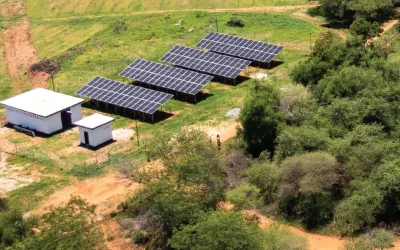Zim meeting electricity demand
Zimbabwe is meeting its electricity demand except when some of the units at Hwange are taken out for maintenance or to correct anomalies, Permanent Secretary at the Ministry of Energy and Power Development in Zimbabwe. Dr. Eng. Gloria Magombo has said.
Speaking at an Economic Policy Dialogue organised by the Zimbabwe National Chamber of Commerce on Wednesday Dr Magombo said at Hwange the installed capacity is now at 1 000MW.
Hwange Thermal Power Station has been producing an average of 970MW since September 23, 2023 helping the country to produce an average 1 500MW per day during that period.
Zimbabwe this year commissioned Units 7 and 8 at its Hwange Power Station with a combined 600MW being added to the national grid this year.
The coming on stream, of the two units, has significantly reduced load shedding across the country.
“Our current supply capacity does meet our demand. The only challenge which we have, and will have from time to time is the availability of some of the units in Hwange, in particular, because we do have about 1000MW of currently installed capacity versus about 400MW which we had prior to the commissioning of Unit 7 and 8.
“But from time to time, we will take out, maybe one unit from which is 300MW in Hwange that gives us a challenge and we have to load shed on the few days when we are correcting the anomaly.
“But in terms of capacity, we do have capacity to meet our demand,” said Dr Magombo.
She said when the old units are rehabilitated to make them more efficient, there will be fewer challenges or load shedding.
Dr Magombo however said capacity at Kariba will be affected by the availability of water as the region is facing an El Nino.
Dr Magombo said there are opportunities for independent power producers to add to what is available for own use or for sale to other users.
“As I speak right now we have over 50 to 60MW or solar systems, the biggest being a 12MW at a mining company which are self supplying.”
An additional 50 to 60MW are under construction from private players, she said.
Turning to the prevailing tariffs, Dr Magombo said power has been overly subsidised over the years with ZESA achieving tariffs as low as US 3 cents because of exchange rate issues.
“And industry has enjoyed almost US 2 cents cost of electricity, but thats not what the cost is in reality and its important to realise that,” said Dr Magombo.
She said ZESA should apply cost-reflective tarrifs as this would attract the private sector to come and argument supply.
“As government, our role is to ensure that we address sustainability issues, but the most important part is energy security.
“Its cheaper for you to get power at US 10 to 15 cents per kWh on a daily basis coming from your utility than not having that power and resorting to running a generator which will cost you 40 cents per kWh,” said Dr Magombo.
She said there is need to increase production of power as well as improve on energy efficiencies.
Dr Magombo said there is still scope for reducing energy consumption, investing in energy efficiency as well as developing new energy sources.
She revealed that there are opportunities for repurposing some of the old plants using new technology.
The improved power supply comes as a relief to businesses and households that last year and early this year endured long hours of power cuts.
At the end of November last year, the hydro plant in the Kariba Dam had to be switched off for lack of volume passing through its turbines, according to the Zambezi River Authority which manages the water supply.
And with Hwange 7 and 8 yet to be commissioned it was left to the old plants, which frequently broke down, as the only source of power.
The southern African country is however now faring much better than South Africa also going through a power crisis.
South Africa is facing a severe power crisis, with frequent and extended blackouts becoming a daily reality for many South Africans.
South Africa’s coal-fired power plants are prone to breakdowns as they are old and poorly maintained.
Eskom, the state-owned utility that generates and transmits most of South Africa’s electricity, has been plagued by corruption and mismanagement and this has undermined the company’s ability to invest in new infrastructure and maintain its existing assets.-ebsunessweekly








